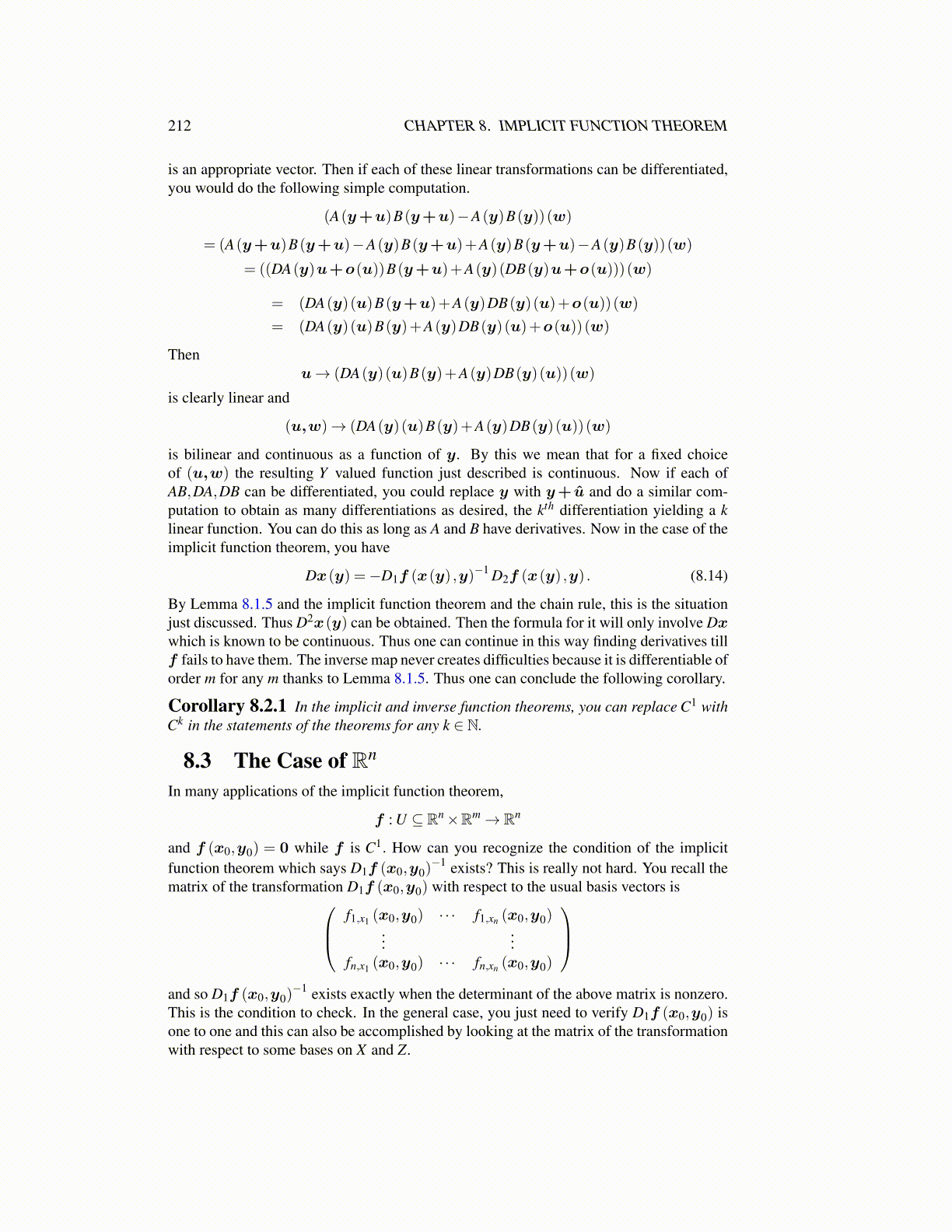
212 CHAPTER 8. IMPLICIT FUNCTION THEOREM
is an appropriate vector. Then if each of these linear transformations can be differentiated,you would do the following simple computation.
(A(y+u)B(y+u)−A(y)B(y))(w)
= (A(y+u)B(y+u)−A(y)B(y+u)+A(y)B(y+u)−A(y)B(y))(w)
= ((DA(y)u+o(u))B(y+u)+A(y)(DB(y)u+o(u)))(w)
= (DA(y)(u)B(y+u)+A(y)DB(y)(u)+o(u))(w)
= (DA(y)(u)B(y)+A(y)DB(y)(u)+o(u))(w)
Thenu→ (DA(y)(u)B(y)+A(y)DB(y)(u))(w)
is clearly linear and
(u,w)→ (DA(y)(u)B(y)+A(y)DB(y)(u))(w)
is bilinear and continuous as a function of y. By this we mean that for a fixed choiceof (u,w) the resulting Y valued function just described is continuous. Now if each ofAB,DA,DB can be differentiated, you could replace y with y+ û and do a similar com-putation to obtain as many differentiations as desired, the kth differentiation yielding a klinear function. You can do this as long as A and B have derivatives. Now in the case of theimplicit function theorem, you have
Dx(y) =−D1f (x(y) ,y)−1 D2f (x(y) ,y) . (8.14)
By Lemma 8.1.5 and the implicit function theorem and the chain rule, this is the situationjust discussed. Thus D2x(y) can be obtained. Then the formula for it will only involve Dxwhich is known to be continuous. Thus one can continue in this way finding derivatives tillf fails to have them. The inverse map never creates difficulties because it is differentiable oforder m for any m thanks to Lemma 8.1.5. Thus one can conclude the following corollary.
Corollary 8.2.1 In the implicit and inverse function theorems, you can replace C1 withCk in the statements of the theorems for any k ∈ N.
8.3 The Case of Rn
In many applications of the implicit function theorem,
f : U ⊆ Rn×Rm→ Rn
and f (x0,y0) = 0 while f is C1. How can you recognize the condition of the implicitfunction theorem which says D1f (x0,y0)
−1 exists? This is really not hard. You recall thematrix of the transformation D1f (x0,y0) with respect to the usual basis vectors is f1,x1 (x0,y0) · · · f1,xn (x0,y0)
......
fn,x1 (x0,y0) · · · fn,xn (x0,y0)
and so D1f (x0,y0)
−1 exists exactly when the determinant of the above matrix is nonzero.This is the condition to check. In the general case, you just need to verify D1f (x0,y0) isone to one and this can also be accomplished by looking at the matrix of the transformationwith respect to some bases on X and Z.